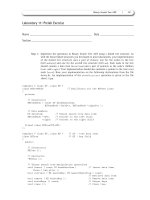A Laboratory Course in C++Data Structures phần 5 pot
Bạn đang xem bản rút gọn của tài liệu. Xem và tải ngay bản đầy đủ của tài liệu tại đây (430.73 KB, 43 trang )
Laboratory 7: Postlab Exercise 1
Singly Linked List Implementation of the List ADT | 155
Name __________________________________________ Date _______________________
Section _________________________________________
Given a list containing N data items, develop worst-case, order-of-magnitude estimates of the
execution time of the following List ADT operations, assuming they are implemented using a
linked list. Briefly explain your reasoning behind each estimate.
insert O( )
Explanation:
remove O( )
Explanation:
gotoNext O( )
Explanation:
gotoPrior O( )
Explanation:
156 | Laboratory 7
Laboratory 7: Postlab Exercise 2
Singly Linked List Implementation of the List ADT | 157
Name __________________________________________ Date _______________________
Section _________________________________________
Part A
In-lab Exercise 3 introduces a pair of approaches for implementing an insertBefore operation.
One approach is straightforward, whereas the other is somewhat less obvious but more efficient.
Describe how you might apply the latter approach to the remove operation. Use a diagram to
illustrate your answer.
Part B
The resulting implementation of the remove operation has a worst-case, order of magnitude
performance estimate of O(N). Does this estimate accurately reflect the performance of this
implementation? Explain why or why not.
158 | Laboratory 7
In this laboratory you will:
Analyze the limitations of the default copy
constructor, assignment operator, and equality
operator
Develop and implement an improved copy
constructor, assignment operator, and equality
operator for the singly linked implementation of the
List ADT
Learn about and implement a convert constructor
Learn how to use the object’s pointer this to
improve function behavior
Copying and
Comparing ADTs
Objectives
Overview
Whenever a variable is passed to a function using call by value, the compiler makes a
copy of the variable. The function then manipulates this copy rather than the original
argument. Once the function terminates, the copy is deleted.
How does the compiler know how to construct a copy of a particular argument?
For C++’s predefined types, this task is straightforward. The compiler simply makes a
bitwise (bit-by-bit) copy of the argument. Unfortunately, this approach does not work
well with instances of classes such as the singly linked list that contain dynamically
allocated data. Consider what happens when the call
dummy(testList);
is made to the following function:
void dummy ( List<DT> valueList );
A bitwise copy of list testList to list valueList copies pointers testList.head
and testList.cursor to pointers valueList.head and valueList.cursor. The
linked list of data items pointed to by testList.head is not copied and there are now
two pointers to the same linked list of data items. As a result, changes to valueList
also change testList, clearly violating the constraints of call by value. In addition,
when the function terminates, the List class destructor is called to delete the copy
(valueList). As it deletes valueList’s linked list of data items, the destructor also is
deleting testList’s data.
Fortunately, C++ provides us with a method for addressing this problem. We can
specify exactly how a copy is to be created by including a copy constructor in our List
class. The compiler then uses our copy constructor in place of its default (bitwise) copy
constructor.
Classes that have problems because of the default copying behavior also encounter
similar problems when assigning one object to another. This is solved in C++ by
overloading the assignment operator (‘=’). A number of other operators, for example,
the comparison operator (‘==’), also do not function as expected because they do a
bitwise comparison of the pointers instead of comparing the data that the pointers
reference.
These problems arise because of a failure to distinguish between identical data and
equivalent data. To help put this into perspective, imagine that you are at a pizza
restaurant. The waiter comes to your table and asks if you are ready to order. You are
in a hurry, so you glance around and notice that the pizza at the next table looks
good. You tell the waiter, “I’ll have what they’re having.” Imagine the surprise if the
waiter were to walk over to the next table, pick up their pizza, and put it down on
your table for you to eat. You had probably meant that you wanted to have an
equivalent pizza, not the very same identical pizza.
Although this is not a perfect analogy, when C++ needs to make a copy of a data
structure, it does what the waiter did and tries to give you an exact copy. By default,
the C++ compiler works with a shallow version of the data structure in which the
values of the pointers are treated as the real data to be copied or compared—a copy is
identical. Instead, we need to work with a deep version of the data structure—the
values of the pointers must be dereferenced to find the actual data structure items that
need to be copied or compared. Initialized objects should end up containing equivalent
160 | Laboratory 8
data. We can ensure correct program behavior by providing copy constructors and
overloading the necessary operators. Note that if you do not provide a copy
constructor and overload the assignment operator, your program is likely to fail with
strange and hard-to-diagnose errors involving memory references. The rule of thumb
for deciding whether or not you need to provide a copy constructor and overloaded
assignment operator is as follows:
If the class contains pointers and performs dynamic memory allocation, you should—at a
minimum—implement the copy constructor and overload the assignment operator.
It is possible to learn all the situations under which the problems can arise—such as
passing a list object as a value parameter—and try to avoid those situations, but it is
very easy to make mistakes. Do not take shortcuts. Failure to implement the copy
constructor and overloaded assignment operator will come back to haunt you.
The prototype for the copy constructor for an arbitrary class, C, is as follows:
C ( const C &value );
The object value is what the constructor must use to initialize the local data. Although
the data in value is probably private, this is not a problem for the constructor code
because objects of a given class are permitted to access all parts of another object of
the same class.
The prototype for the overloaded assignment operator is as follows:
void operator = ( const C &value );
The function behavior here will be almost identical to that of the copy constructor. The
differences stem from the fact that with the copy constructor we are initializing a
new—not previously initialized—object, whereas with the overloaded assignment
operator we are reinitializing an already initialized object. Care must be taken during
reinitialization to avoid causing memory leaks and other problems. Note that there is
another permissible version of the prototype for the overloaded assignment operator
that does not have a void return type. It will be discussed in Postlab Exercise 1.
Copy constructors are activated in the following three contexts:
• Objects passed by value to a function. The compiler activates the copy constructor
to initialize the function’s local temporary copy of the object.
• Object definition with copy initialization. For example, a new list is defined and is
to be immediately initialized to be equivalent to another list.
List<char> list2 ( list1 );
There are object definition situations that activate a copy constructor even though
it doesn’t look like object definition with copy initialization. For instance, the
statement
List<char> list2 = list1;
activates the copy constructor, not the assignment operation. For reasons partially
covered in In-lab Exercise 3, the assignment operation is not used when a variable
is initialized in its definition.
• Objects returned by value from a function. Whenever a class object is returned by
value from a function, the compiler calls the copy constructor to initialize the
receiving storage.
list2 = buildList( );
Copying and Comparing ADTs | 161
where the prototype of buildList() is something like the following:
List<char> buildList();
Note: The preceding section is based in part on material from Object-Oriented
Programming in C++, Johnsonbaugh and Kalin, 1995, Prentice Hall. This is an
extremely useful book for developing an in-depth knowledge of C++.
162 | Laboratory 8
Enhanced List ADT
Data Items
The data items in a list are of generic type DT.
Structure
The Enhanced List ADT is based on the standard singly linked list presented in Lab 7.
Operations
List ( const List<DT> &valueList ) throw ( bad_alloc )
Requirements:
None
Results:
Copy constructor. Creates a copy of valueList. This constructor automatically is
invoked whenever a list is passed to a function using call by value, a function returns
a list, or a list is initialized using another list.
void operator = ( const List<DT> &rightList ) throw ( bad_alloc )
Requirements:
None
Results:
Assigns (copies) the contents of rightList to a list.
Copying and Comparing ADTs | 163
Assigned: Check or
list exercise numbers Completed
Laboratory 8: Cover Sheet
Copying and Comparing ADTs | 165
Name __________________________________________ Date _______________________
Section _________________________________________
Place a check mark in the Assigned column next to the exercises your instructor has assigned to
you. Attach this cover sheet to the front of the packet of materials you submit following the
laboratory.
Prelab Exercise
Bridge Exercise
In-lab Exercise 1
In-lab Exercise 2
In-lab Exercise 3
Postlab Exercise 1
Postlab Exercise 2
Total
Copying and Comparing ADTs | 167
Name __________________________________________ Date _______________________
Section _________________________________________
In this laboratory you will create a copy constructor and overload the assignment operator for the
singly linked list implementation of the list ADT.
Step 1: Test the (default) copy constructor and assignment operator for your singly linked
implementation of the List ADT (Lab 7) using a copy of your listlnk.cpp that you should
save in the file listlnk2.cpp. Also use the provided Lab 8 listlnk2.h and the test program
given in the file test8.cpp. What happens? Why?
Step 2: Implement the List ADT copy constructor and assignment operator using the singly linked
implementation of the List ADT (Lab 7) that you have stored in listlnk2.cpp. The
following declaration for the singly linked list class is given in the file listlnk2.h.
template < class DT > // Forward declaration of the List class
class List;
template < class DT >
class ListNode // Facilitator class for the List class
{
private:
// Constructor
ListNode ( const DT &nodeData, ListNode *nextPtr );
// Data members
DT dataItem; // List data item
ListNode *next; // Pointer to the next list node
friend class List<DT>;
};
//
template < class DT >
class List
{
public:
// Constructors
List ( int ignored = 0 );
List ( const List<DT> &srcList ) // Copy constructor
throw ( bad_alloc );
// Destructor
~List ();
void operator= ( const List<DT> &srcList )
throw ( bad_alloc );
// List manipulation operations
void insert ( const DT &newData ) // Insert after cursor
throw ( bad_alloc );
void remove () // Remove data item
throw ( logic_error );
void replace ( const DT &newData ) // Replace data item
throw ( logic_error );
void clear (); // Clear list
// List status operations
bool isEmpty () const; // List is empty
bool isFull () const; // List is full
// List iteration operations
void gotoBeginning () // Go to beginning
throw ( logic_error );
void gotoEnd () // Go to end
throw ( logic_error );
bool gotoNext ()
throw ( logic_error ) // Go to next data item
bool gotoPrior ()
throw ( logic_error ); // Go to prior item
DT getCursor () const // Return item
throw ( logic_error );
// Output the list structure — used in testing/debugging
void showStructure () const;
private:
// Data members
ListNode<DT> *head, // Pointer to the beginning of the list
*cursor; // Cursor pointer
};
168 | Laboratory 8
Laboratory 8: Bridge Exercise
Copying and Comparing ADTs | 169
Name __________________________________________ Date _______________________
Section _________________________________________
Check with your instructor whether you are to complete this exercise prior to your lab period
or during lab.
The test program in the file test8.cpp allows you to interactively test your implementation of
the Enhanced List ADT using the following commands.
Command Action
+x Insert data item x after the cursor.
N Go to the next data item.
P Go to the prior data item.
C Test the copy constructor.
= Test the assignment operator.
! Double check the assignment operator.
Q Quit the test program.
Step 1: Prepare a test plan for your implementation of the List ADT. Be sure to test that your
copy constructor and assignment operator work with empty lists. A test plan form
follows.
Step 2: Implement your new functions in the file listlnk2.cpp.
Step 3: Execute the test plan. If you discover mistakes in your implementation of the copy
constructor and assignment operator, correct them and execute the test plan again.
Test Plan for the New Operations in the Enhanced List ADT
Test Case Commands Expected Result Checked
170 | Laboratory 8
Laboratory 8: In-lab Exercise 1
Copying and Comparing ADTs | 171
Name __________________________________________ Date _______________________
Section _________________________________________
You are now familiar with the copy constructor and have the knowledge to decide when there is a
need to implement your own copy constructor. C++ also permits the definition of other
constructors that, although nonessential, can be extremely useful.
A convert constructor allows you to initialize an object by passing an object of a different
type. You have probably already used this with the C++ string class as given in the following
example,
string lastName( “Smith” );
the C-string “Smith”—of a different type than string—is used to initialize the string object.
Convert constructors can be used with a wide range of initialization types. To give you
experience implementing a convert constructor, we will ask you to create one for the singly linked
implementation of the List ADT that will accept a Logbook as the initializer. For the purposes of
this exercise, assume the list contains integers.
List ( const Logbook &log )
Requirements:
Log is a valid logbook.
Results:
Constructor. Creates a list representation of the logbook containing appropriate entries for the
logbook month, year, number of days in the month, and each of the days in the month.
Step 1: Copy logbook.h and logbook.cpp to your Lab 8 directory. Modify the listlnk2.h file to
include logbook.h and insert the convert constructor prototype underneath the other
constructor declarations in the List class declaration.
Step 2: Implement the convert constructor described above and add it to the file listlnk2.cpp.
Step 3: Copy the file test-convert.cs to test-convert.cpp. The first half of the program is provided
from the Lab 1 prelab and allows the user to enter data into a logbook. The second half of
the program starts with the following lines:
// Create a list to represent the logbook and display
// the log using the singly-linked list.
List<int> logList( testLog );
cout << endl
<< “Now printing same logbook from linked list” << endl;
// Insert your code below. It should include the month, year,
// number of days in the month, and a printout of the logbook
// data from logList identical to the logbook listings above.
// All the necessary data from testLog should now be in
// logList—do NOT use testLog from here on.
LogList
should now contain all the information that testLog contains. Use only
logList to implement the missing part of the program. Your added code should
produce the following output.
Now printing same logbook from linked list
Logbook created for Month : 8, Year : 2002
# days in month : 31
1 1 2 2 3 3 4 4 5 0
6 0 7 0 8 0 9 0 10 0
11 0 12 0 13 0 14 0 15 0
16 0 17 0 18 0 19 0 20 0
21 0 22 0 23 0 24 0 25 0
26 0 27 0 28 0 29 0 30 30
31 31
Step 4: Complete the test plan for the convert constructor and the code you added to
print out the logbook data.
Step 5: Execute the test plan. If you discover mistakes in your implementation of the
convert constructor or your logbook data display, correct them and execute
the test plan again.
Test Plan for the Convert Constructor and Test Program
Test Case Logbook Month # Days in Month Checked
Simple month 1 2003 31
Month in the past 7 1969
Month in the future 12 2011
February (nonleap year) 2 2003
February (leap year) 2 2004
172 | Laboratory 8
Laboratory 8: In-lab Exercise 2
Copying and Comparing ADTs | 173
Name __________________________________________ Date _______________________
Section _________________________________________
We have examined how the behavior of the default C++ copy constructor and assignment operator
can cause run-time errors and cause the program to halt in mid-execution. Less catastrophic—but
still unacceptable—behavior is exhibited by a number of the other default C++ operators whenever
the deep version of the data structure must be used instead of the shallow version. For instance,
the comparison operator (‘==’) gives invalid results when comparing two equivalent but distinct
singly linked lists because it compares the values of the head and cursor pointers instead of
comparing the data items in the lists.
bool operator == ( const List &rightList )
Requirements:
None
Results:
Compares the deep structure values of a list to that of rightList. If they are the same—that is,
equivalent values—then returns true. Otherwise, returns false.
Step 1: Implement this operation and add it to the file listlnk2.cpp. A prototype for this operation
is included in the declaration of the List class in the file listlnk2.h.
Step 2: Activate the ‘?’ (equal?) command in the test program in the file test8.cpp by removing
the comment delimiter (and the character ‘?’) from the lines that begin with ‘//?’.
Step 3: Prepare a test plan that covers various lists, including empty lists and lists containing a
single data item. Note that you can set the value of the second list in the test program by
using the ‘=’ command. A test plan form follows.
Step 4: Execute your test plan. If you discover mistakes in your implementation of the reverse
operation, correct them and execute your test plan again.
Test Plan for Test ? (Equality Comparison Operation)
Test Case Commands Expected Result Checked
174 | Laboratory 8
Laboratory 8: In-lab Exercise 3
Copying and Comparing ADTs | 175
Name __________________________________________ Date _______________________
Section _________________________________________
In complex programs with pointers, it is possible to have multiple references to the same object.
Although probably not intended, it is possible to accidentally write a C++ statement assigning an
object to itself. A statement such as
list1 = list1;
is not likely to be written by a programmer and would most likely be removed by an optimizing
compiler as a useless statement. However, it might be possible to have a C++ statement like
List<int> *listPtr;
listPtr = &list1;
// Intermediate statements
. . .
*listPtr = list1;
that would sneak past the optimizer. This code is assigning the list to itself.
The main problem here is not that the C++ compiler might fail to remove an unneeded
statement, but something much more serious.
Step 1: Activate the ‘S’ (test self-assignment) command in the test program in the file test8.cpp
by removing the comment delimiter (and the character ‘S’) from the lines beginning with
“//S”.
Step 2: Compile test8.cpp and run the executable. Place some data into the list and then choose
the ‘S’ command. What happens? Why did it happen?
The copy constructor is run to initialize a new object and consequently there is no need to
clear out previous data. The problem that occurs with the assignment operation is that the list is
already initialized and may contain data. Before the list can be reinitialized, any existing data
must be removed properly by returning the list nodes to the memory manager. The next step is to
have the list initialize itself to itself, but it just finished deallocating all of its nodes, leaving
nothing to copy.
The solution is to verify that the object is not copying from itself. This can be easily achieved
by using the pointer named this that the C++ compiler places in each object and initializes to the
address of the object. Because each object has a unique memory address, an object can verify
whether or not it is the same as another object by comparing the contents of this to the address
of the other object.
Step 3: Complete the following test plan by adding test cases that check whether your
implementation of the assignment operation correctly handles the assignment to self
problem.
Step 4: Modify your operator=() function in listlnk2.cpp so that no harm is done if
the list is passed itself as the initialization model.
Step 5: Execute your test plan. If you discover mistakes in your implementation of
these operations, correct them and execute your test plan again.
Test Plan for the Corrected Assignment Operation
Test Case Commands Expected Result Checked
176 | Laboratory 8
Laboratory 8: Postlab Exercise 1
Copying and Comparing ADTs | 177
Name __________________________________________ Date _______________________
Section _________________________________________
There are two possible prototypes for the overloaded assignment operator. The one used in the
prelab is
void operator = ( const List<DT> &rightList )
Given three list objects—list1, list2, and list3—you set list2 and list3 to the same value as
list1 as follows:
list2 = list1;
list3 = list1;
The other prototype for the assignment operator changes the return type from void to
List<DT>& as follows:
List<DT>& operator = ( const List<DT> &rightList )
The List<DT>& is a reference to the list that can be used in further expressions such as multiple
assignments on the same line. For instance, this permits
list3 = list2 = list1;
and
if (( list2 = list1 ) == list3 )
The code for the two versions of the function are identical except for the last line on the second
version—the one with return type List<DT>&. As mentioned in In-lab 3, every object has a
compiler-generated pointer named this that contains the object’s address. To return a reference to
the object, the second function adds the line
return *this;
Which version of the assignment operator function is preferable? Explain your reasoning.
Copying and Comparing ADTs | 179
Name __________________________________________ Date _______________________
Section _________________________________________
Consider all the ADTs covered so far in this lab book—Logbook (1), Point List (2), Array
implementation of the List (3), Ordered List (4), Stack (5), Queue (6), and Singly linked
Implementation of the List (7). Which of them need to have a copy constructor and an overloaded
assignment operator? Explain your reasoning.









